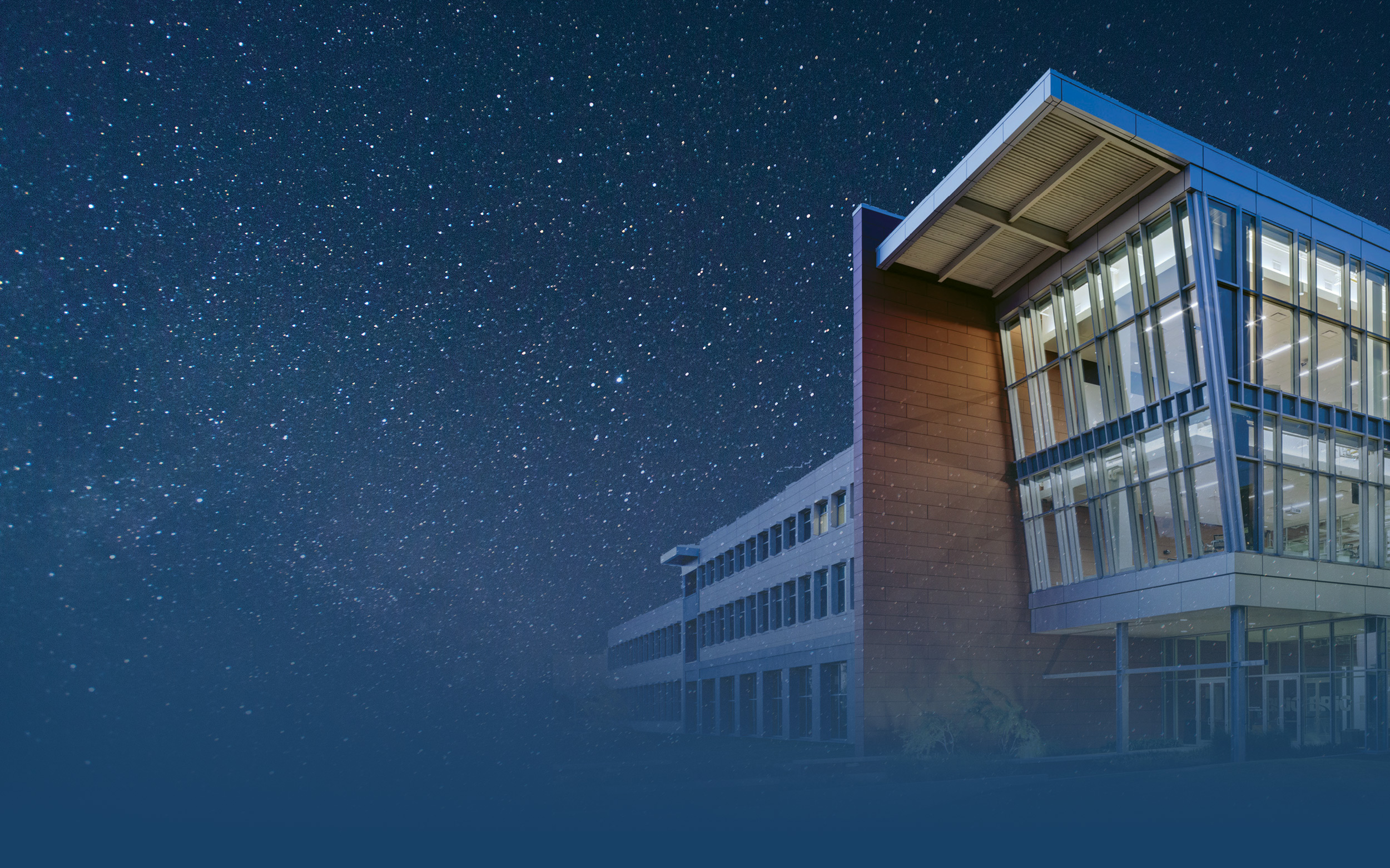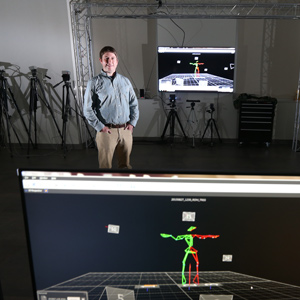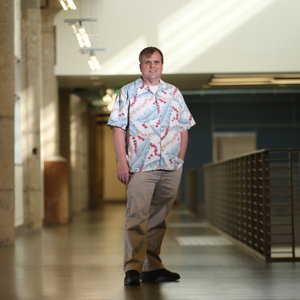The Rx for Research
ECS faculty members are blazing trails in collaborative research with meaningful real-world applications in the healthcare and medical fields - and beyond.
When the doors of the Baylor Research and Innovation Collaborative (BRIC) opened in January 2013, the excitement throughout the Baylor and greater Waco community was virtually palpable. After all, this 300,000-square-foot state-of-the-art facility, which stands as the cornerstone of a 21-acre discovery park that will evolve into the Central Texas Technology and Research Park, heralded a new beginning for Baylor not only as a top teaching university with a deep Christian commitment, but also a nationally ranked research institution replete with inspiring spaces for research centers, wet and dry labs, workforce training, academic symposia and more.
But as exciting as it was to see this architectural masterpiece unveiled, the even greater excitement was yet to unfold behind its walls as faculty, students and fellow collaborators embarked on an unprecedented journey to exchange innovative ideas and conduct interdisciplinary research under a single roof. And among those researchers blazing trails in cutting-edge research with real-world applications are faculty and students from Baylor’s School of Engineering & Computer Science (ECS), with some of the most exciting advances emerging in the healthcare and medical fields.
Keeping in Motion
While engineering and computer science may not be the first areas of study that come to mind for most people when thinking of healthcare and medical research, those who are experts in the field know that they are not only natural fits, but also critical links in the research process.
“MDs and PhDs see things differently; MDs apply existing knowledge, and PhDs apply advanced knowledge,” says Baylor regent Dr. Ron Wilson, a graduate of the Baylor College of Medicine who has been serving on the Board of Regents for six years. “The relationship between the two is synergistic and crucial to improve quality of life for members of the community and to advance as a society.”
And it’s this synergy that’s at the heart of much of the research being conducted at the BRIC. “The BRIC brought the community of Waco and Baylor together by providing a catalyst—an incubator, if you will—for research that can be a connection with local businesses,” says Dr. Wilson. “It provides a place to do high-quality research, brings together PhDs in commercial work with peers in similar research, fosters international connections, and helps attract top-level faculty who want to teach and do research. I love all Baylor sports, but I really love the BRIC and what it can mean to the community.”
ASSISTANT PROFESSOR OF MECHANICAL ENGINEERING
Among those top faculty engaged in teaching and dedicated to conducting pioneering research is Dr. Jonathan Rylander, assistant professor of mechanical engineering. “The lab space at the BRIC was one of the major draws of my coming to Baylor,” says Dr. Rylander, whose research involved studying and improving walking stability in wounded service members with amputations at the Brooke Army Medical Center in San Antonio prior to joining Baylor. “I’m committed to growing research, and the BRIC provides the environment for a nice marriage of doing collaborative research.”
Indeed, collaboration is often key when it comes to making meaningful advances in the healthcare and medical fields. So when Dr. Wilson met Dr. Rylander at a University-hosted dinner and learned of his research on orthopedic biomechanics and rehabilitation issues, he immediately drew a connection and introduced him to Dr. Garrison Benton, an orthopedic surgeon at Baylor Scott & White Health in Waco who, before completing his medical degree at Texas Tech School of Medicine, graduated from Baylor with a degree in electrical engineering.
Today, Dr. Rylander and Dr. Benton are collaborating on groundbreaking research in the new motion-capture laboratory at the BRIC. They’re using motion-capture technology to quantify movement quality for patients who have undergone a total hip replacement via an anterior surgical approach. Of particular interest is whether retaining the capsule surrounding the hip will have any functional benefit to the patient. The goal of the research is to help patients restore their function and, thereby, their quality of life.
“Orthopedic biomechanics involves studying the human body from a mechanical standpoint, including how the forces from the ground transfer up your body,” explains Dr. Rylander, who has two graduate students assisting him in the lab and several undergraduate students aiding in data collection. “The new lab at the BRIC allows us to use motion-capture technology, similar to that used in producing animation and video games, to measure and assess whether treatments are effective for people with walking difficulties. And how we’re applying [this technology] is the even cooler part.”
While doctors often assess the efficacy of treatment and outcomes for a patient’s functional quality through surveys, surveys are subjective and short-term, says Dr. Rylander, adding that even medical imaging is a static measure. “We provide an additional set of information by quantifying how someone’s function has improved with motion-capture tests that objectively track the patient’s movements before surgery and after surgery. We can then use motion capture as a way to inform doctors about outcomes. We can also use it as a prescription tool; therapy is a big issue.”
Dr. Rylander can remember always having a special interest in the relationships between mechanics and medicine. Currently, he is also collaborating with Dr. Jason Wilken, a physical therapist who is head of research at the Center for the Intrepid in San Antonio, on research focused on the potential use of exer-gaming technology and software as rehabilitation tools for people with ACL tears, hip impingement and amputation. And in a third project in collaboration with Dr. Matthew Schmitz at the Brooke Army Medical Center in San Antonio and Dr. Marc Safran at Stanford University, he is examining hip braces as possible conservative treatment options for patients with the hip condition Femoroacetabular Impingement.
As medicine becomes more patient-centered and advances are made more quickly than ever, the crossover of engineering and medicine grows, notes Dr. Rylander. “Engineers give doctors information to help outcomes and help them be more patient-centric and individual-specific”—cultivating a synergistic relationship that continues to improve people’s health and better their lives.
Unlocking the Patterns
PROFESSOR OF ELECTRICAL AND COMPUTER ENGINEERING
In another new hi-tech laboratory in the BRIC, Dr. Keith Schubert, professor of electrical and computer engineering (promotion recently awarded after the magazine went to print), is also delving into groundbreaking research with medical applications that could potentially help people with cancer live better and longer lives through treatment using proton and ion therapy.
While radiation therapy kills off cancer cells, it damages everything around it, depositing most of that damage near the surface before it ever even hits the targeted area, explains Dr. Schubert. “With proton and ion therapy, most of the energy is deposited at the end, causing almost no damage. This type of therapy has been used successfully for more than 30 years—mostly aimed at treating cancers of the brain and spine, as well as prostate cancer—but the big issue is if you’re off slightly of the targeted area, you can cause a lot of damage to nearby tissue,” he says. “We’re trying to improve the accuracy by better quantification of the material properties of the body that the treatment’s protons and ions are passing through, so we’re imaging the body using protons. We get more reliable 3D images using about one-tenth of the radiation. The decrease in wasted radiation is an added benefit.”
Dr. Schubert is also studying how this therapy can be optimally applied in surgery by taking advantage of the rest period of a patient’s heart and targeting the cancer during that rest time. “Proton and ion beams can be used without stopping the heart during surgery,” he explains, adding that this research could also be applied to patients with cardiac arrhythmia. “To account for the motion of the heart and lungs, we’re tracking the heart by working with new devices such as a bio-bed that doesn’t require any LEED hookups. You don’t want to hook up a patient with metal wires when doing this kind of surgery.”
In research that began in 2006 at the Loma Linda University Medical Center in California, Dr. Schubert is collaborating with Dr. Erich Baker, professor in bioinformatics, to investigate what triggers the carcinogenic process and to analyze different types of treatments to help prevent patients from relapsing into cancer.
In all of these endeavors, the resources of the BRIC are making a significant difference.
“One of the reasons I came to Baylor [about two-and-a-half years ago] was because of the resources available. My work is computational and requires a lot of computer resources, and the BRIC provides access to equipment, lab space and a computer cluster that allows me to track a billion protons going through the human body and study how they affect surrounding cells,” says Dr. Schubert, adding that when he invites colleagues from around the world to the BRIC, “they’re stunned and slightly jealous” by the BRIC’s aesthetic appeal and hi-tech environment.
“I also have 10 graduate students who are top-notch and, through our Christian commitment, are motivated to help people. They are a tremendous support,” he says. “And I have a friendly, open and helpful group of colleagues I can bounce ideas off of, and we help each other. There’s also been a lot of support for [external] grants.”
But not all of Dr. Schubert’s research is performed in the BRIC. In fact, much of his work is in the biological sphere researching microbial communities to discover patterns of life in “extreme environments” such as caves in Mexico and Hawaii, the frigid frontiers of Alaska and the deserts of California, Australia and Israel.
“Small communities of organisms gather together and start growing in maze-like patterns in response to the conditions of the environment—for example, low food or water or extreme temperatures,” explains Dr. Schubert, who, in collaboration with Dr. Robert Marks, distinguished professor of electrical and computer engineering, is studying “swarm systems” and developing mathematical descriptions of biological systems. “Using time-lapse technology, we see how those patterns evolve and how things change over time to make predictions.”
Such studies show that biological organisms tend to gather where life-sustaining resources are available, forming highly structured patterns to use those resources, explains Dr. Schubert. “These same patterns are repeated no matter the group,” he says. “There’s also evidence of how organisms try to survive when stressed—how they pick a safe spot to keep themselves alive—which also relates to issues in climate change.”
Beyond those issues are implications about the possibility of life existing outside our planet, notes Dr. Schubert. In December 2013, he was part of a group of academic and NASA scientists who traveled on a National Geographic Society-funded expedition to a cave laced with toxic sulfuric acid near Tapijulapa, Mexico, to answer that very question. Their mission was to study images of the microbial communities forming patterns on the cave walls using special camera equipment built and installed by Dr. Schubert.
Analyzing those patterns, Dr. Schubert developed cellular automata and equations that could help predict the movement of biological communities and assess the health of various extreme environments. Tracking the movement of billions of microbes daily in this controlled environment over a period of years, Dr. Schubert and his colleagues are looking to unlock the key to how microorganisms survive in extreme environments—a key that could provide a “universal signature” to biological patterns and perhaps even answer the question of whether life exists beyond Earth. (An article about this expedition, titled “The Hunt for Life Beyond Earth,” was featured in the July 2014 issue of National Geographic.)
Back at the BRIC, ECS faculty, students and collaborators continue to pursue answers to such vital questions that affect our daily lives—and promise to impact the lives of generations to come—providing critical pieces to complex puzzles in healthcare, medicine and more, one exciting breakthrough at a time.
Watch the video above and learn more about Dr. Greg Hamerly's White Eye Detection App and reserch.


